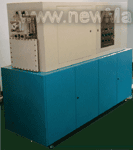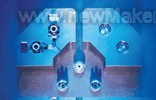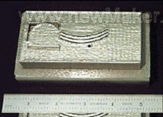Laser processing in the mold industry
Foreword With the development of science and technology and the diversification of social needs, the competition for products has become more and more fierce, and the cycle of renewal has become shorter and shorter. To this end, it is required to not only design new products as soon as possible according to market requirements, but also to prototype in the shortest possible time, so as to perform performance testing and modification, and finally form a shaped product. In the traditional manufacturing system, a large amount of mold design, manufacturing and debugging work is required, and the cost is high and the cycle is long, which is unable to adapt to the ever-changing market changes. In order to improve the speed of research and development and production, quickly and accurately produce high-quality, low-cost molds and products, and can respond agilely to market changes, people have done a lot of research and exploration work. With the continuous decline in the price of industrial lasers and the increasing maturity of industrial laser processing technology, it has brought about major changes in mold manufacturing and product production processes. This paper first introduces industrial processing lasers, and then introduces and analyzes several aspects such as mold laser manufacturing, mold surface laser strengthening and replacement, mold laser repair, and mold laser cleaning. Industrial processing laser At present, there are two main types of industrial lasers for laser processing: solid-state lasers and gas lasers. Among them, solid-state lasers are represented by Nd:YAG lasers; gas lasers are represented by CO 2 lasers. With the development of laser technology, high-power fiber lasers and high-power semiconductor lasers have also begun to be used in certain processing applications. 1.Nd:YAG laser The laser working substance of the Nd:YAG laser is a solid Nd:YAG rod with a laser wavelength of 1.06 μm. Due to the low laser conversion efficiency of the laser and the limitation of the YAG rod volume and thermal conductivity, the average laser output power is not high. However, since the Nd:YAG laser can compress the pulse width of the laser output through the Q switch, it can obtain a very high peak power (108W) when operating in a pulse mode, which is suitable for laser processing applications requiring high peak power; another great advantage It can be transmitted through optical fiber, avoiding the design and manufacture of complex transmission optical paths, and is very useful in 3D machining. In addition, the laser wavelength can be converted to 355 nm (ultraviolet) by triple frequency technology, which is applied in the laser stereo forming technology. 2.CO 2 laser CO 2 laser laser material is a mixed gas of CO 2, the laser wavelength is the main application 10.6μm. Since the laser has high laser conversion efficiency, and the heat generated by the laser can be quickly transmitted to the laser gain region by convection or diffusion, the average power of the laser output can be achieved at a high level (over 10,000 watts). High power laser processing requirements. High-power CO 2 lasers for laser processing at home and abroad are mainly cross-flow and axial-flow lasers. (1) Cross-flow laser: The beam quality of the cross-flow laser is not very good. It is a multimode output and is mainly used for heat treatment and welding. At present, China has been able to produce a variety of high-power cross-flow CO 2 laser series, which can meet the needs of domestic laser heat treatment and welding. (2) Axial flow laser: The axial beam laser has good beam quality and is the basic mode or quasi-base mode output. It is mainly used for laser cutting and welding. The laser cutting equipment market in China is mainly occupied by foreign axial current lasers. Although domestic laser manufacturers have done a lot of work on foreign axial current lasers, because the main parts still need to be imported, the price of the products is difficult to drop drastically and the penetration rate is low. Wuhan Bole Technology Development Co., Ltd. has developed a swirling CO 2 laser. As shown in Figure 1, the swirling CO 2 laser has both axial and CO 2 laser beam quality and cross flow in a new rotating gas flow mode. The CO 2 laser has the advantages of low cost and small volume. The promotion and application of this kind of industrial processing laser will play a positive role in promoting the development and popularization of China's laser processing industry. Figure 1. Wuhan Bole Technology Development Co., Ltd. 500W cyclone CO2 laser Mold laser manufacturing Laser indirect molding process (1) Stereo Lithography Apparatus (SLA) process is a method of forming a three-dimensional solid workpiece by scanning a light-curing adhesive layer by layer with an ultraviolet laser beam. In 1986, 3D Systems of the United States introduced the commercial prototype SLA-1. The highest machining accuracy of the SLA process can reach 0.05mm. (2) Laminated Object Manufacturing (LOM) process uses thin-film materials, such as paper, plastic film, etc., which was successfully developed by Helisys in the United States in 1986. The solid workpieces produced in layers are obtained by repeated CO2 laser cutting and material bonding. The LOM process is characterized by its ability to manufacture large workpieces with an accuracy of 0.1 mm. (3) Selective Laser Sintering (SLS) process is formed by using powdered materials. It was successfully developed by the University of Texas at Austin in 1989. It is layer by layer with high-intensity CO2 laser. Selectively scanning the sintered material powder to form a three-dimensional workpiece, the biggest advantage of the SLS process is that the material selection is more extensive. Due to the long development time and relatively mature technology, the above three laser rapid prototyping technologies have been widely used at home and abroad. However, the three-dimensional workpiece formed by the above method cannot be directly used as a mold, and needs to be subjected to subsequent processing, so it is called a laser indirect molding process. The main treatment methods are: (1) Rapidly formed workpieces are used as molds after processing. The paper mold made by LOM is directly replaced by the sand casting wood mold by surface treatment; or the paper mold made by LOM is directly used as a low melting point alloy mold, an injection mold by surface treatment, or a forming mold of the wax mold in lost wax casting. The workpiece made by SLS is used as a metal mold after copper infiltration. (2) Using a rapid-formed part as a master mold to cast silicone rubber, epoxy resin, polyurethane and other materials to make a soft mold. (3) Reducing the hard mold with a rapid forming part. One is to directly make a paper-based mold with LOM, and then cast a metal mold by surface metal arc spraying and polishing; the other is a metal surface hard backing mold. The above hard mold can be used for sand casting, molding of lost foam, injection molding, and simple non-steel tensile molding. The above-mentioned laser indirect molding process is used to make the mold, which avoids the complicated mechanical cutting process and ensures the precision of the mold, and can greatly shorten the molding time and save the molding cost. For the complex shape precision mold, the advantage is especially protruding. However, there are still shortcomings in the relatively short life of the mold, so the above laser indirect forming mold is more suitable for small batch production. 2. Laser direct molding process Selective Laser Melting (SLM) technology was developed based on selective laser sintering (SLS) technology. The characteristics of SLM are: (1) processing the metal with a laser beam of high power density and small spot, so that the metal part has a dimensional accuracy of 0.1 mm; (2) The parts made of molten metal have metallurgical bonded entities, and the relative density can reach almost 100%, which greatly improves the performance of metal parts; (3) Since the laser spot diameter is small, it is possible to melt a high melting point metal at a low power, making it possible to manufacture a part from a single component metal powder. Figure 2 shows an all-metal part manufactured by EOS GmbH in Germany using a selective laser melting (SLM) process. Figure 2 Full metal parts manufactured by EOS GmbH in Germany using selective laser melting (SLM) Laser multi-layer (or three-dimensional / three-dimensional) cladding direct rapid prototyping technology is a high-tech manufacturing technology developed on the basis of rapid prototyping technology combined with synchronous feeding laser cladding technology, the essence of which is computer-controlled 3D laser Cladding. Due to the rapid solidification characteristics of laser cladding, the metal parts produced have a uniform and fine dendritic structure and excellent quality, and their density and performance are comparable to those of conventional metal parts. Laser multilayer cladding has developed a variety of methods, the most representative of which is the metal developed by Sandia National Laboratories called Laser Engineered Net Shaping (LENS). Rapid prototyping technology. This method has successfully produced stainless steel, maraging steel, nickel-based superalloy, tool steel, titanium alloy, magnetic material and nickel-aluminum intermetallic compound workpieces, and the density of parts reaches nearly 100%. Figure 3 shows a metal mold manufactured by the Sandia National Laboratory in the United States using LENS technology. Figure 3 Full metal mold made by Laser Engineering Net Forming Process (LENS) by Sandia National Laboratories, USA Next page Fasteners Screw,Socket Set Screw,Hex Socket Flat Head Screw,Special Cold Forged Trapezoid Head Screws Suzhou Gubao Screws Co.,Ltd. , https://www.gbscrewes.com

